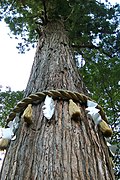This article may require cleanup to meet Wikipedia's quality standards. The specific problem is: Many problematic entries: links to non-existent Wiktionary pages, mistaken romanization, misspellings of the Japanese, incorrect glosses.(July 2022) |
This article needs additional citations for verification .(March 2022) |
This is the glossary of Shinto , including major terms on the subject. Words followed by an asterisk (*) are illustrated by an image in one of the photo galleries.
Contents
- A
- B
- C
- D
- E
- F
- G
- H
- Gallery: A to H
- I
- J
- K
- Gallery: I to K
- M
- N
- O
- Gallery: M to O
- R
- S
- Gallery: R to S
- T
- U
- W
- Y
- Z
- Gallery: T to Z
- See also
- Notes
- References
| Part of a series on |
| Shinto |
|---|
 |







































